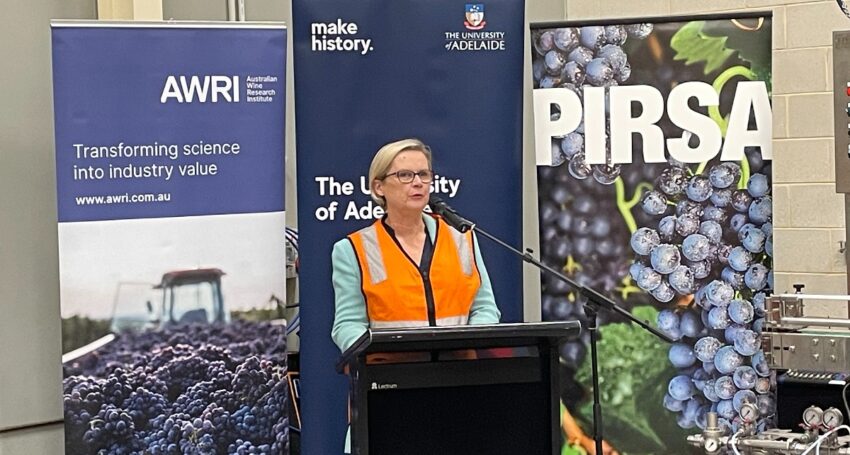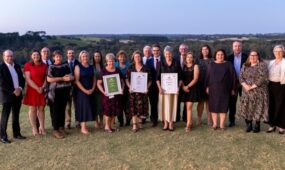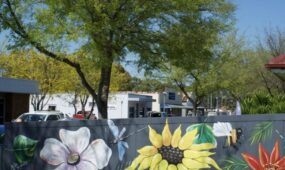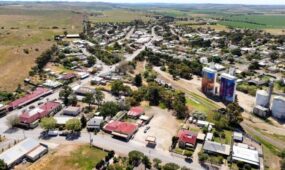No-alcohol wine lab launched in Adelaide
Regional
South Australian grape and wine producers will soon be able to access a facility to experiment with no and low-alcohol wine products for a rapidly growing global market.

Sign up to receive notifications about new stories in this category.
Thank you for subscribing to story notifications.

The University of Adelaide and the Australian Wine Research Institute officially launched the $1.98m laboratory at the university’s Waite campus on Wednesday.
The SA Government through Primary Industries and Regions South Australia (PIRSA) has funded the facility to diversify the use of wine grapes.
It’s hoped the initiative could provide an answer to finding a home for the glut of red wine in the marketplace caused by the tariffs of up to 218.4 per cent imposed on Australian wine by China until March 2025.
Minister for Primary Industries and Regional Development Clare Scriven said the global NOLO market was valued at $1.58 billion in 2020 and was growing rapidly.
“The NOLO industry is extremely strong in Australia and growing year by year,” she said.
“By accessing the trial-scale facility, they [winemakers] have much lower risk to diversify and experiment to create world-class NOLO products.
“In time, this could lead to a skilled, specialist workforce and allow the industry to capitalise on significant market opportunities available.”
Australian Wine Research Institute research scientist Wes Pearson is leading the AWRI’s research on NOLO wines.
He said the centrepiece of the facility was a custom-built spinning cone column developed by a New South Wales company Flavourtech, based in Griffith in the Riverina.
“This pilot-scale machine removes the ethanol from the wine and processes about 70 litres an hour, compared to the 10,000 litres an hour that can be achieved by a commercial-sized one,” Pearson said.
He said using this type of equipment was considered by many in the wine industry as the most popular method to remove alcohol from wine to produce NOLO products.
“It can separate volatile components from a liquid,” Pearson said.
“In wine, it separates the ethanol and a proportion of the volatile aroma and flavour components from the rest of the wine.”
Pearson said the ethanol extracted from the wine could be used for other purposes such as making fortified wine such as port.
He said spinning cone columns were already used for making NOLO wines around the world and were also used extensively to make iced tea or freeze-dried coffee.
The Waite NOLO trial-scale research facility also has equipment to generate steam for the spinning cone column and a canning machine.
A counter pressure filler is also available to assist in packaging samples of new products made within the facility, including sparkling wine products.
Pearson said the aim of the facility was to encourage the wine industry to diversify its use for grapes.
He said under the NOLO wine initiative South Australian grape and wine producers could access the facilities at subsidised rates for up to 15 days.
Minister Scriven said SA producers would be able to use as little as 150 litres of wine in the spinning cone column, where commercial-scale equipment, which has traditionally been used to develop new wine products, requires 10,000 litres.
Pearson said wine producers were being encouraged to experiment with new products at the facility in a low-risk venture using a small amount of their wine.
“This hasn’t really been done in the wine industry before,” he said.
“Typically, we haven’t focused on developing products, we grow grapes and turn them into wine, it is a 2000-year-old product.”
Pearson said other drinks made from fermented grapes could also be trialled at the University of Adelaide’s Waite campus.
He said a new generation of consumers was keen to have access to a variety of drinks made from grapes.
“The millennials just don’t play by the same rules that others have followed in the past,” he said.
“They are not tied to having wine in a bottle or the label.
“They are just looking for a tasty beverage, so if you can package your wine in a can and it suits them for the occasion that they are drinking, then they are all for it.”
Pearson said he hoped wine growers who become confident in the products they trial would pursue commercial production in the future.
“It is an opportunity for grape and wine producers to expand their portfolio and to get into the game where they haven’t been able to before, due to difficulty in accessing technology,” he said.
Jump to next article




